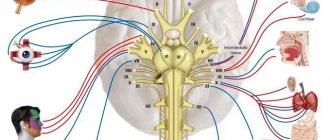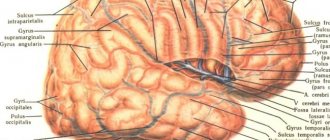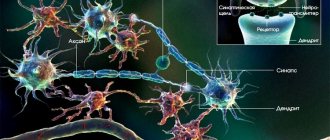The olfactory brain consists of brain structures that support the function of smell. Adequate interaction of the body with the external environment is ensured by sensory systems. The sense of smell is an innate sense, helps to find food, is involved in the regulation of sexual behavior, and contributes to the enjoyment of the aroma of flowers and fruits. Using the sense of smell, a person perceives danger signals, for example, catching and identifying the smells of chemicals or spoiled food.
Characteristic
In anatomy, the olfactory brain is closely interconnected with the limbic system, which determines the joint regulation of many body functions, for example, the formation of emotions and the perception of odors. The olfactory system in the cortex is projected in the area of the anterior segment of the hippocampal gyrus. The olfactory analyzer perceives and analyzes odor. The system supports the following functions:
- Determining the suitability of food by smell.
- Regulation of eating behavior. The pleasant smell of food stimulates appetite.
- Stimulates the activity of the digestive tract. The smell of food, according to the principle of a conditioned reflex, triggers the mechanisms of digestion and food processing.
The structure of the olfactory brain involves close interaction between the departments - the amygdala within the limbic system, the hippocampus, the orbitofrontal and temporal (medial part) areas of the cortical layer. The vaulted gyrus (gyrus fornicatus) consists of parts - the cingulate, parahippocampal gyrus, and isthmus.
The central section within the olfactory brain includes the olfactory bulb, located in the area of the forebrain where the primary processing of information coming from the external environment occurs. The olfactory center within the brain is located in the lower segment of the temporal and frontal cortical layers covering the cerebral hemispheres.
The cortical sections perform secondary processing - they identify the smell, comparing it with stored data formed as a result of the accumulation of life experience. After identification, a general reaction of the body is formed that is adequate to the situation. As part of the central section of the combined structures - the olfactory brain and the limbic system, there are elements:
- Gyri – parahippocampal, cingulate, dentate, orbital.
- Hippocampal (seahorse) hook.
- Areas of the cortex in the frontal, parietal part, temporal pole, insular zone.
- Reticular formation.
- Basal ganglia (nuclei formed by gray matter inside white matter).
- Hypothalamus (a region of the intermediate part of the brain involved in the regulation of homeostasis - maintaining a constant environment in the body).
- Transparent septum (triangular, thin membrane separating the horns of the lateral ventricles).
The peripheral section within the olfactory brain includes bulbs, triangles, and pathways. The peripheral section also includes the perforated substance (a section of the cerebral hemisphere pierced with holes for blood vessels, located on its lower surface posterior to the triangle) and olfactory stripes (branches of the olfactory sulcus). The part of the brain responsible for smell interacts with the analyzer, which is represented by the following departments:
- Receptor. Contains receptors located in the mucous membrane of the upper nasal passages. In total, humans have about 10 million receptors that perceive odors.
- Conductive. The olfactory nerve, consisting of 15-20 nerve filaments passing through the ethmoid bone in the direction of the anterior fossa of the cranium.
- Bulbs (bulbus olfactorius), pathways, triangles and other subcortical structures of the system.
- Cortical area. Located in the lower segment of the temporal lobe and uncus in the region of the parahippocampal gyrus.
The olfactory triangle is a part of the brain that regulates the function of smell, which is represented by the expansion of pathways that transmit signals from receptors to the cortical analyzer. The olfactory triangle (trigonum olfactorium) borders the perforated substance. The mechanism of odor perception is realized through the comparison of odorous molecules with receptors located in the villi of neurosensory cells.
Separate groups of receptors perceive certain aromatic molecules. Several groups of receptors are involved in the recognition of one odor, the total number of which can reach several thousand. Information entering the brain along the pathways is summarized and compared with data stored in memory.
The process of adapting information about an aromatic substance lasts several seconds or minutes. The duration of the process depends on the concentration of the aromatic substance in the air and the speed of air flow in the area of the olfactory epithelium. The sensitivity of human receptors is quite high. The receptor responds to a single molecule of aromatic substance.
Methods for diagnosing smell disorders
When a problem is identified, a comprehensive examination is necessary.
- Olfactometry - allows you to determine the degree of decrease in perception.
- Endoscopic examination of the nasal cavity - examination is necessary to identify pathologies.
- Computed tomography of the nasal cavity and paranasal sinuses is necessary to identify neoplasms and inflammation.
- Laboratory examination - allows you to identify concomitant diseases that lead to impaired perception (diabetes mellitus, hyperthyroidism).
- MRI of the brain - allows you to identify brain diseases that lead to a disorder of smell (demyelinating diseases, tumors of the anterior cranial fossa).
Functions
Thanks to the ability to distinguish odors, a person receives information about the surrounding biochemical environment. Other functions of the olfactory brain are associated with the formation of instinctive reactions when interacting with the outside world. The sense of smell in the context of the formation of reflex behavioral patterns in response to external stimuli covers the nutritional, protective, sexual, and orientation spheres of the body’s life. The olfactory brain and limbic system are structures that are involved in the regulation of processes:
- Formation of emotions.
- Behavioral, motivational reactions.
- Sleep-wake mode.
- Learning, intuition and memory.
Odorants are volatile substances that have an odor. Once in the nasal passages, odorants reach the olfactory epithelium (Regio olfactorius), where they interact with chemoreceptors. The olfactory zone is located on the mucosal surface in the upper region of the nasal passages, covers an area of about 2.5 cm2, and contains about 50 million sensory neurons.
Axonal branches of nerve cells pass through the ethmoid bone towards the olfactory bulb within the brain. Here the processes form synaptic connections with the dendrites of second-level nerve cells and unite into glomeruli. Level 2 neurons include mitral (the largest cellular elements) and tufted cells. Their branches emerge from the bulb, which is a multilayer neural network.
The axons of nerve cells (mitral, fascicular) extending from the bulb transmit information to the primary zones of the cortex, where the stimulus is decoded, the information is interpreted and an adequate reflex response is formed. The signal is then transmitted to the center of smell, located in the cortical layer of the brain, which regulates the higher functions of the psyche, where a conscious sensation of aroma arises.
At the same time, the stimulus enters the limbic system, where emotions and conscious behavioral reactions are formed that are adequate to the perceived smell. Odorants are transmitted predominantly along unmyelinated (not covered with a protective layer of myelin) nerve fibers. Impaired smell function worsens a person's quality of life. For example, many people with such disorders have impaired digestive function, which is due to the close relationship between the smell and taste of food.
Types of smell impairment
There are several types:
- Hyposmia is a decrease in the function of smell.
- Anosmia is a complete loss of the sense of smell (typical of COVID-19).
- Hyperosmia is an increased reaction (usually negative) to faint odors.
- Parosmia is a distortion of perception (a person’s sensations do not coincide with how the substance actually smells).
- Cacosmia is the sensation of unpleasant odors in the absence of their sources.
- Olfactory hallucinations are the sensation of unusual odors in the absence of a real stimulus.
Folk remedy to solve the problem
How to restore your sense of smell? You can resort to the advice of traditional medicine. The following remedies will perfectly help get rid of mucus:
- Take 150 grams of horseradish, grate it, add the juice of two or three lemons. Mix. Take one teaspoon twice a day on an empty stomach.
- A mixture of nasal drops is prepared as follows: take mint and eucalyptus. Place everything in a liter jar, pour in olive oil (it should cover the mixture). Leave until the mass becomes homogeneous. Drop twenty drops into each nostril in the morning and evening. Keep your head up for a few minutes. The resulting mixture should be stored in a dark place.
When do you smell better?
You already know that smell is a sense. You are probably wondering who has it more developed. It has long been believed that women have the best sense of smell. But more recently, scientists have come to the conclusion that representatives of the fair half of humanity are better at classifying and recognizing odors, but men perceive aromas as a signal to action.
Age also affects the sense of smell. People recognize odors best during puberty. By the age of forty-five, this feeling begins to fade, and by seventy, many no longer feel subtle aromas.
The weather also affects the sense of smell. In hot weather, odors are usually stronger.
Therapeutic baths
In order to restore the sense of smell, it is necessary to adhere to a certain sequence during treatment:
- Soften the mucus. To do this, it is recommended to make a steam bath. It will also help cleanse the lungs and bronchi. Three procedures of 15-20 minutes each will be enough. Remember that if you have dry facial skin, apply cream to it before the procedure.
- For greater steam efficiency, add young dill, sage, mint or nettle to the water.
- Bend over the bath and cover your head with a towel. Inhale through your nose, exhale through your mouth.
- After the bath, take a shower, but do not wet your head.
- Stretch your body. To do this, you can wave your arms, legs, bend and rotate your head and torso.
Interesting Facts
It is believed that the sense of smell arose first among all the senses and occupied a dominant position in the early stages of phylogenesis. It is the sense of smell that allows animals to find food and detect danger, and for the perception of pheromones and the search for a partner, nature has even created a separate system - the vomeronasal organ. The most important function of the sense of smell is to pay attention to danger (smoke, toxic fumes) or potentially beneficial odors (the smell of food).
It has been proven that the sense of smell plays an important role in social communication, for example: contact between mother and newborn, the choice of a future spouse. Nostalgic memories are very often associated with the sensation of smells.
What is missing most when losing the sense of smell is the pleasure that people experienced from food and drink. Such patients are more likely to suffer from depression.
A few more facts
American scientists Richard Axel and Linda Buck received the Nobel Prize in 2004 for their discovery of a family of genes encoding olfactory receptors.
Interestingly, the family of genes encoding olfactory receptors outnumbers, for example, the family of genes for visual receptors.
Description of a complex process
Recognizing odors is not an easy task. And the idea that we perceive aromas through the nose is deceptive. This organ only helps us inhale. After this, the air enters the olfactory epithelium. It contains neurosensory cells. They react very actively to the presence of odor and send impulses to different parts of the brain: the olfactory cortex, hypothalamus, hippocampus. Only after this does a person begin to become aware of the smell, remember it and identify it. In addition, the hypothalamus can store associative memory. It is thanks to her that smells often give rise to certain memories.
The sense of smell is the ability to remember a large number of odors and classify them. Why is this happening? Scientists have expressed the following opinion. Olfactory neurons contain a large number (about a thousand) receptor proteins. Each receptor has only one protein and is responsible for a specific smell. There are ten million olfactory neurons in humans, and each of them has a large number of receptors. So thanks to this, we can recognize a huge number of odors, but separately.
Treatment methods
Conservative treatment tactics depend on the cause. It is imperative to take into account whether the patient has suffered from Covid.
Conservative treatment
Impaired sense of smell caused by inflammation of the nasal mucosa.
Conservative therapy is carried out aimed at reducing swelling of the mucous membrane and eliminating the cause of inflammation.
For this, nasal rinsing using antiseptics is used.
Drugs are used that reduce inflammation and swelling of the nasal mucosa.
Physiotherapy procedures are carried out: magnetic laser therapy, halotherapy, phonophoresis.
Antiviral therapy, antibacterial therapy, and oral antiallergic therapy may be prescribed.
Toxic damage to the olfactory nerve and receptors.
Anti-inflammatory and detoxification therapy is carried out.
Drugs are prescribed that act to improve the transmission of nerve impulses (prozerin, B vitamins).
Physiotherapy is used to improve microcirculation, as well as restore the function of the olfactory nerve (magnetic laser therapy, phonophoresis).
Surgery
Surgical treatment is most effective for smell disorders caused by:
- polyps or chronic sinusitis
- deviated septum
- hypertrophy of the nasal turbinates
Surgical methods for treating pathology:
- polypotomy or polysinsotomy
- septoplasty
- conchoplasty
These types of operations are performed under general anesthesia using endoscopic techniques, radio wave or laser equipment. This makes it possible to reduce the risk of postoperative bleeding, reduces the time spent in the hospital, and reduces the rehabilitation period.
Our clinic deals with various cases of deterioration in the ability to perceive odors, including impaired sense of smell after coronavirus.
Therapy and nutrition
When a problem arises, a person does not always strive to go to the doctor; in most cases, he tries to find the answer to the question of how to restore his sense of smell. Most often, home treatment is successful if you have simple rhinitis.
When you have a cold, mucous fluid accumulates gradually. But the appearance of mucus is also influenced by nutrition. If your diet is high in starchy or processed foods, your sense of smell may be lost. If this happens, then the first thing you should take care of is changing your diet. During treatment, you can even switch to vegetarian food or simply give up fatty meat. In addition, you will have to limit the consumption of milk and potatoes, and also exclude confectionery and bakery products, everything fatty and smoked, and sugar from your diet.
Let's talk about hyperosmia
A person can not only lose their sense of smell, but also, on the contrary, acutely perceive all odors. Hyperosmia is a heightened sense of smell. Most often it appears in the following cases:
- In pregnant women.
- In people who have mental illness.
- With multiple sclerosis.
- For migraines, brain tumors.
- For infectious diseases.
This condition manifests itself as follows: sick people perceive odors much more intensely than healthy people. To treat hyperosmia, restorative therapy is used.
Structure of the nose
A person senses smells through the nose. Before talking about the sense of smell, you should understand what this organ is. After all, its cavity performs a very important function - it cleans the air of dust and unnecessary particles. It is possible to understand how this whole process occurs only when you know the person. Its anatomy is as follows:
- There are small hairs at the entrance. They are a kind of barrier that prevents the entry of foreign particles and dust.
- The goblet glands are also unique protectors of the human body, as they secrete mucus. It, in turn, is characterized by antiseptic properties, due to which pathogenic bacteria are destroyed. In addition, mucus prevents dry and cold air from entering the human body.
- - these are four walls: lower, upper, medial, lateral.
- An area where there are a large number of blood vessels.
- Osteochondral septum. It divides the nasal cavity into two equal parts. Its curvature can lead to difficulty breathing.
We looked at the structure of the human nose. The anatomy of this organ has its own characteristics. Much depends on the correctness of its structure.
Summarizing all of the above, we can conclude that the nose consists of two parts: the outer part and the nasal cavity. This body performs the following functions:
- protective;
- resonant;
- olfactory and others.










